Tool test: Belt sanders for woodworkers
Asa Christiana put 10 midsize belt sanders to work flat-sanding both panels and edges, sanding curves and tight corners, and using the tool as a stationary sander while clamped to a benchtop.
Synopsis: More aggressive than a random-orbit sander and more portable than a benchtop sander, a handheld belt sander shines when there’s a lot of material to remove and you want to bring the sander to the work vs. the work to the sander. Asa Christiana put these midsize models to work flat-sanding both panels and edges, sanding curves and tight corners, and using the tool as a stationary sander while clamped to a benchtop. In the end, four stood out from the pack.
The belt sander is a tool most woodworkers don’t need every day, but it proves invaluable when called upon for a range of odd jobs. Contractors and finish carpenters, on the other hand, use theirs more frequently, for fitting—or “scribing”— cabinet frames and moldings to walls and floors, trimming the edges of sticky doors, leveling one floorboard to another, and a grab-bag of other job-site tasks.
Testing for versatilityI gave the sanders a workout to evaluate how well they handle a number of different jobs in the shop.
|
More aggressive than a random-orbit sander, and more portable than a benchtop sander (disk, belt, or spindle) a handheld belt sander shines when there is a lot of material to remove and it makes more sense to bring the sander to the work vs. the work to the sander. Part of the belt sander’s versatility comes from the different ways you can hold the tool—from right side up to sideways to vertical—to address the work, and the different parts of the sander you can use, such as the flat section (the platen), the front roller, or a bit of both.
See how the test was done:
In this video, Asa Christiana demonstrates the test he put
10 belt sanders through so you know which one will earn it’s
spot in your shop.which one will earn it’s keep.
Two newer models—Triton and Tacklife—can be mounted upside down on a work table as a stationary machine, letting you sand smaller pieces held in your hands, such as router templates made from thin stock, and making it possible to get by without a benchtop sander. The rest can be clamped on their sides for the same purpose, even if it’s not shown in the manual.
With its continuous pull in one direction, the belt sander requires a bit of practice to master, but once you do, it becomes a powerful, precise tool for a range of woodworking, remodeling, and DIY jobs, like stripping the paint off a flea-market find.
To help you figure out which brand and model is right for you, we picked the most popular size, 3×21 (the belt is 3 in. wide by 21 in. long). This size has a reasonably large contact surface yet is still easy to handle. We gathered up 10 models available in stores and online, and I put them through a series of tests designed to replicate common uses of this tool.
Tough tests simulate typical tasks
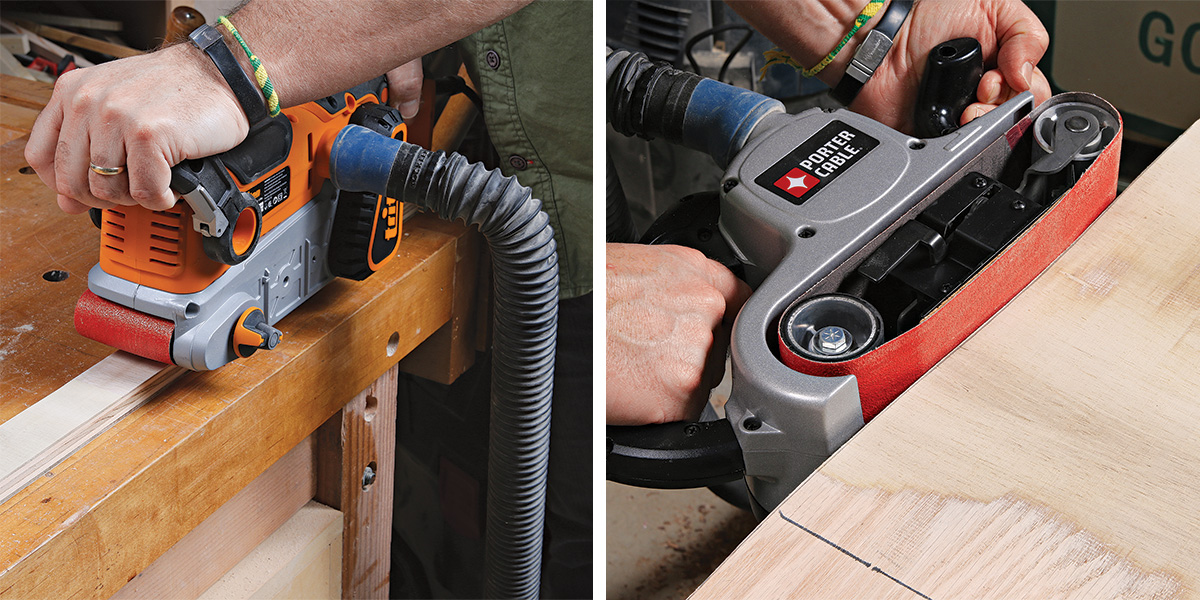
First, to level the playing field, I removed the sanding belt included with each model and put on a fresh 80-grit belt from a single manufacturer. In the process, I checked the belt-changing lever and belt-tracking adjustment. I also checked the trigger lock, which is essential on a belt sander, allowing you to release the trigger and hold the two handles in the most comfortable position for best control. And I checked for variable speed, which isn’t essential but helps with fine shaping.
Most of the tests for each sander fit onto a single piece of oak plywood, roughly 24 in. square. To check each tool’s balance, control, and footprint on a large, flat panel, and its ability to remove a uniform layer of material, I marked off a section on the plywood and attempted to remove just the outer veneer layer. I timed this test to check the rate of stock removal.
To see how easy it is to control the sander on a narrow surface, like the edge of an entry door, I cut off a 2-in. strip of plywood and attempted to remove an even layer from that, too. I combined the strip and the large-surface tests into one rating for sanding flatness.
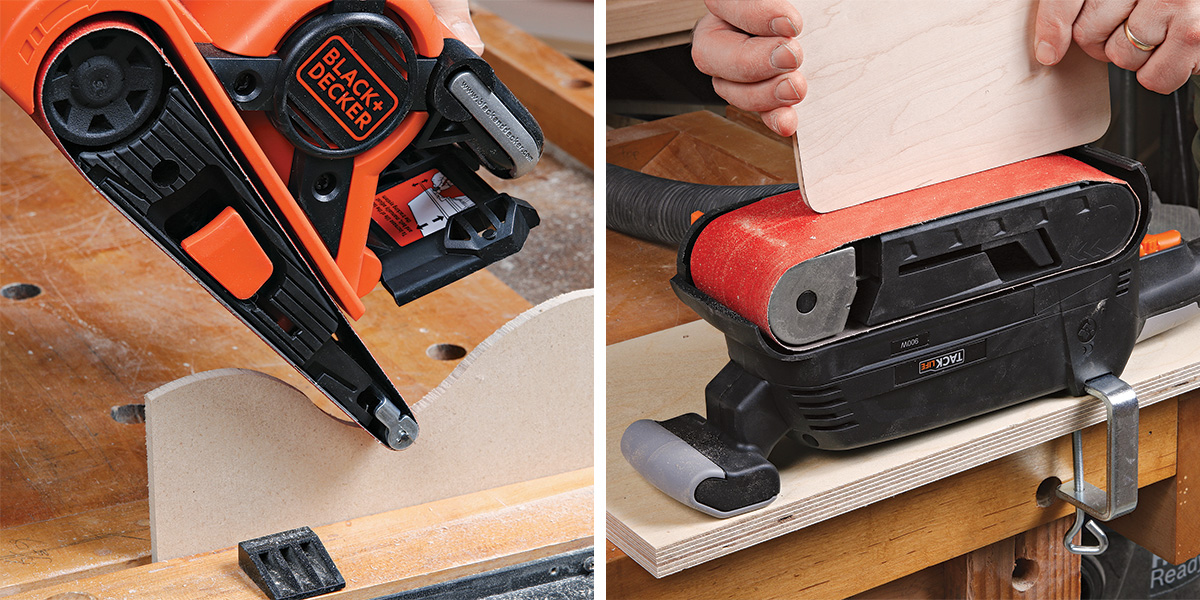
Next, to see what it was like to hold the sander on its side and work up to a line, I set up a simple scribing and shaping test. I penciled a wavy line along one edge of the plywood, sanding in and out of the shallow curves, and added a compass-drawn radius at one end to try sanding a smooth round corner.
Dust wars—Each of these sanders comes with a dust bag, but if it was possible to attach my vacuum hose to the sander’s dust port with a standard round adapter, I did so. Without active suction, even the best leave piles of dust that make it hard to see pencil lines and gauge progress, and produce clouds of dust. Some have odd-shaped openings, and attaching the hose required duct tape (which doesn’t hold), so I stuck with the onboard bag for those.
New features are hit-and-miss
Always looking to differentiate their products with innovative features, tool manufacturers tend to tinker. In the case of belt sanders, however, some of the latest touches didn’t make it past a workshop reality check, and in some cases made matters worse.
The narrow front rollers on a few newer models are designed to allow the nose of the sander to get into tighter corners—sanding flooring close to the wall, for example. But the platen—the pressure plate on the bottom of the tool—can only come so close to the roller on any belt sander, so nose rollers tend to dig in. To get close to a vertical surface, like a wall, it’s better to orient the sander sideways. Track the belt toward the open side of any of these sanders, and they’ll all sand within 1/8 in. of an obstruction.
The other intended use for the narrow front rollers is to sand into tight curves, but a narrow roller can’t do that smoothly.
As for the two sanders—Triton and Tacklife—with flat tops and clamps that hold them upside down on the benchtop, the best by far is the Triton, which has two clamp points instead of one, plus a clamp-on fence to keep workpieces from escaping your grip. If I had one of these two sanders, I would probably store it in stationary mode for quick sanding jobs.
Best of the bunch
My favorites in this belt-sander race are the Makita, Metabo, and Triton, with the Porter-Cable coming up short by a nose. All four are heavy duty, solid performers. The Makita is the smoothest operator and leaves the flattest surface, but is a little awkward to hold on its side. A real value at $140, the Metabo does everything well, is comfortable in all positions, and removes material quicker than any of its competitors. While the Triton can’t quite keep up with the others on pure sanding speed, and has a couple of quirks, it flat-sands and shapes very well, adds a handy stationary sanding mode, and offers wonderful adjustments.
3-in. by 21-in. belt sanders, head to head
Makita 9903
Very solidly built, the Makita is a flat-sanding specialist. It had the smoothest feel and pull of any sander in the test, and let me remove material at a very good pace while keeping the surface very flat. I also appreciated the long cord, excellent belt tracking, and easy belt change. The narrow front handle makes it tough to support this heavy tool on its side in mid-air, though I was able to stabilize it by bracing it against my body. The round port makes it easy to attach a vacuum hose, but dust collection was only so-so.
Makita 9903 Belt Sander
Amps: 8.8
Variable speed: Yes
Belt alignment: Excellent
Material removal rate: Very good
Sanding flatness: Excellent
Shaping/scribing: Very good
Handling on side: Fair
Dust collection with hose: Fair
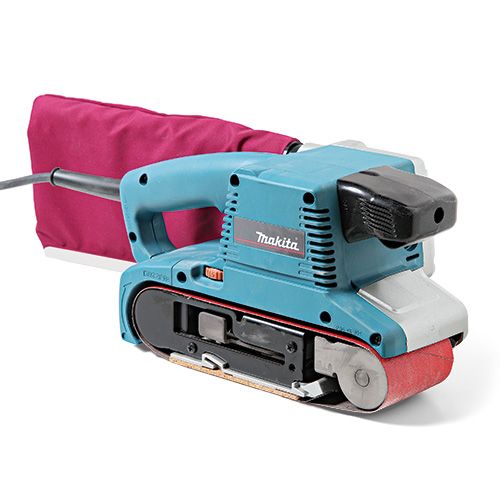
Metabo HPT SB8V2
The Metabo offers unmatched sanding speed, and is comfortable and effective in all positions. Other than a belt-change lever that’s tough to pull, everything else on this sander works very well. I especially like how the front edge of the platen creates smooth inside curves when scribing, how the large rubberized handles add comfort and control, and how the dust port faces backward, keeping the vacuum hose from unbalancing the tool. With the vacuum attached, dust collection was among the best of the bunch.
Metabo HPT SB8V2 Belt Sander
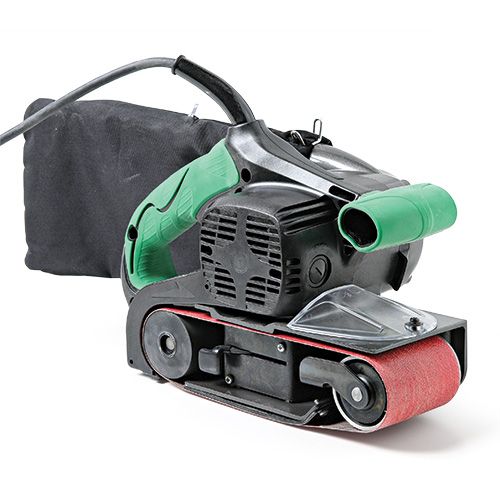
Triton TA1200BS
While not the fastest wood eater, the Triton is the most refined tool in the group, and rivals the Makita for flatness on large surfaces. Controls are a joy to use, including the trigger lock, belt release, and front-handle adjustment—and a small power indicator tells you when the tool is plugged in. The Triton also flips over to sand in stationary mode, with two solid benchtop clamps and a handy fence that screws on to control small workpieces. With a vacuum attached, the Triton collected dust better than any other sander. On the downside, to keep the motor’s air blast out of my eyes when holding the sander on its side, I had to switch my hands and go lefty, which leaves the dust port and hose sticking up a little awkwardly.
Triton TA1200BS Belt Sander
Amps: 10
Variable speed: Yes
Belt alignment: Excellent
Material removal rate: Good
Sanding flatness: Excellent
Shaping/scribing: Very good
Handling on side: Good
Dust collection with hose: Very good

Porter-Cable 352VS
Like the Makita and Metabo, the Porter-Cable is another heavy-duty, powerful tool, edged out by those two on pure speed. It maintains flatness well and is an excellent shaper and scriber. The main downsides are lackluster dust collection and a vertical port that can make it awkward to handle with a vacuum hose attached. The Porter-Cable feels heavy when held sideways, but its handles provide solid, comfortable control. Last, the belt tracking requires occasional tweaking during heavy use.
- Price: $170
- Weight: 10.75 lb.
- Amps: 8
- Variable speed: Yes
- Belt alignment: Good
- Material removal rate: Good
- Sanding flatness: Very good
- Shaping/scribing: Excellent
- Handling on side: Good
- Dust collection with hose: Fair
Black & Decker Dragster, DS321
Very close in design to the Craftsman, this sander has a single-speed motor that makes stock removal extremely slow. The multi-position handle changes easily and makes the tool comfortable to use in all positions. The long sanding footprint is very flat, and a nose flap flips up for sanding inside tight curves, but the narrow front roller makes that difficult. When the belt shifts in use (as all do) and hits the housing, the edge of the belt is damaged, which makes tracking difficult.
Black & Decker Dragster, DS321 Belt Sander
Amps: 7
Variable speed: No
Belt alignment: Poor
Material removal rate: Poor
Sanding flatness: Very good
Shaping/scribing: Good
Handling on side: Very good
Dust collection with hose: N/A
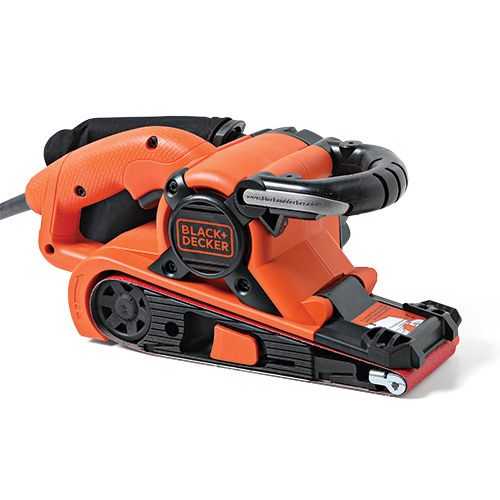
Chicago Electric
The odd-shaped dust-collection port makes it very difficult to attach a vacuum hose, but if you can figure that out or live with the dust, Harbor Freight’s Chicago Electric sander would be fine for light-duty use. With relatively low power, slow material removal, and lightweight plastic construction, this isn’t a sander you want to use every day, or for big jobs. But it’s very inexpensive, comfortable to use in all positions—thanks to its light weight and multi-position front handle—and works OK for all tasks, in all positions, with good flatness on surfaces large and narrow.
Chicago Electric Belt Sander
Amps: 6
Variable speed: Yes
Belt alignment: Good
Material removal rate: Fair
Sanding flatness: Very good
Shaping/scribing: Good
Handling on side: Very good
Dust collection with hose: N/A

Craftsman CMEW213
Very similar in design to the Black & Decker, the Craftsman has a multi-position front handle; a single, slow belt speed; an odd-shaped dust port; and a front flap that allows access to the front roller, which is too narrow for smooth sanding inside the curves it’s designed to access. There are a few differences: The belt-change lever is tougher to move and maintain platen contact under the sander, making flatness difficult to achieve, the material-removal rate is the slowest in the test, and there is a pronounced rumble from the front roller, which vibrates on its axle.
Craftsman CMEW213 Belt Sander
Amps: 7
Variable speed: No
Belt alignment: Poor
Material removal rate: Poor
Sanding flatness: Poor
Shaping/scribing: Poor
Handling on side: Excellent
Dust collection with hose: N/A

Genesis GBS321
Genesis is another dragster-style sander with a narrow front roller. Its top speed is good, with a corresponding rate of material removal, but flatness isn’t great. The odd-shaped dust port makes it nearly impossible to add a vacuum hose, but the onboard bag does collect a fair amount of dust. Strangely, the front flap over the narrow roller looks like it should pivot out of the way but doesn’t. The multi-position front handle helps in all positions, but when holding the sander sideways, I needed to flip it and go lefty to keep the motor’s air blast out of my eyes.
Genesis GBS321 Belt Sander
Amps: 8
Variable speed: Yes
Belt alignment: Excellent
Material removal rate: Good
Sanding flatness: Fair
Shaping/scribing: Very good
Handling on side: Good
Dust collection with hose: N/A

Wen 6321
Wen’s belt sander is another dragster model with a narrow front roller; a single, slow speed; an extremely slow sanding rate; and a dust port whose shape makes a vacuum hose extremely hard to attach. It was easy to maintain a flat surface with the Wen. However, the thin onboard bag blew dust into my face, and the configuration of the platen and rollers made it hard to sand into shallow curves when scribing.
Wen 6321 Belt Sander
Amps: 7
Variable speed: No
Belt alignment: Good
Material removal rate: Poor
Sanding flatness: Very good
Shaping/scribing: Fair
Handling on side: Very good
Dust collection with hose: N/A
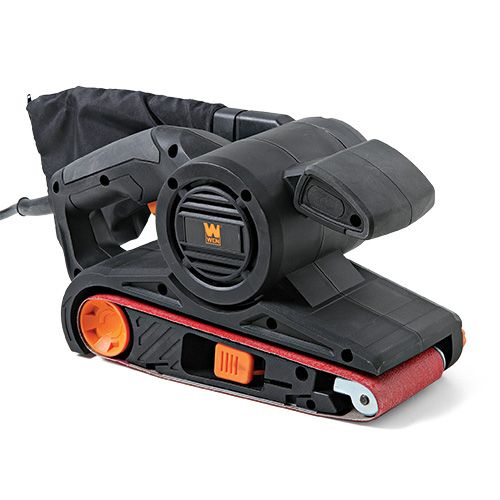
Tacklife PSFS2A
If all you need a belt sander for is scribing and shaping, the Tacklife might be for you. It is very easy to control when held sideways, with a dust port that faces downward in that mode, keeping the hose out of the way and the tool in balance. It also has a flat top and bench clamps so it can be fixed to a table and used as a stationary sander, but it lacks a fence, and the clamps won’t grab thicker benchtops. However, I could not maintain surface flatness with the Tacklife used upright—a deal-breaker for general use—and the belt wandered when I moved the tool from side to side.
- Price: $60
- Weight: 6.5 lb.
- Amps: 8.5
- Variable speed: Yes
- Belt alignment: Fair
- Material removal rate: Fair
- Sanding flatness: Poor
- Shaping/scribing: Very good
- Handling on side: Excellent
- Dust collection with hose: Fair
Asa Christiana is a freelance writer and editor in Portland, Ore.
Photos: Asa Christiana
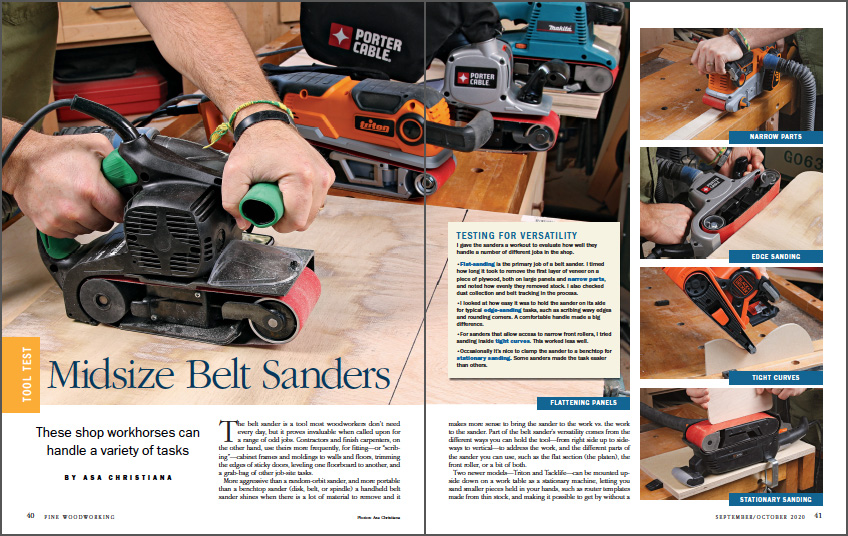
From Fine Woodworking #284
To view the entire article, please click the View PDF button below.
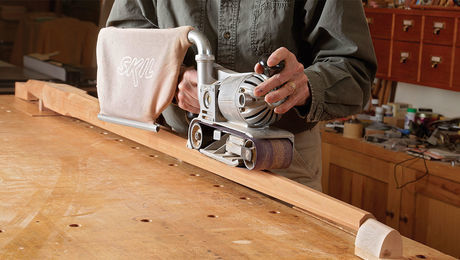 |
|
 |
|
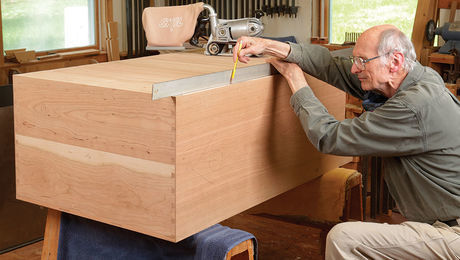 |

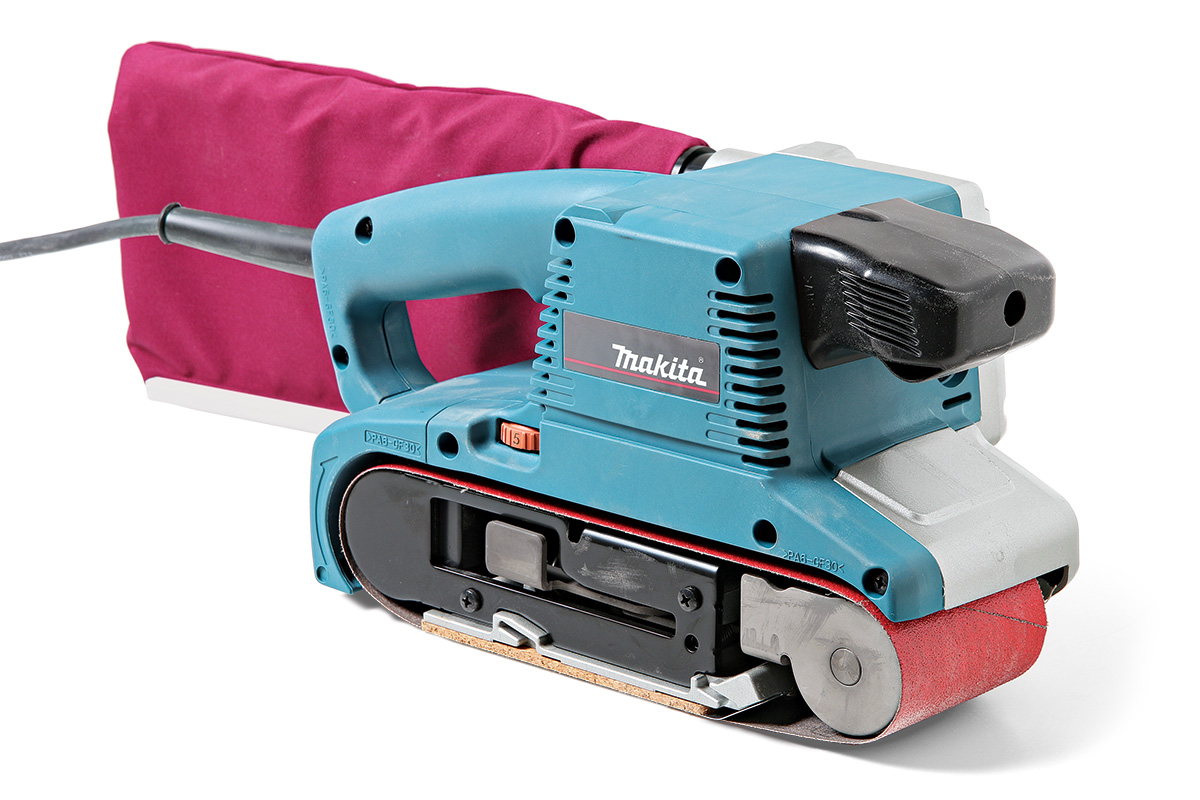
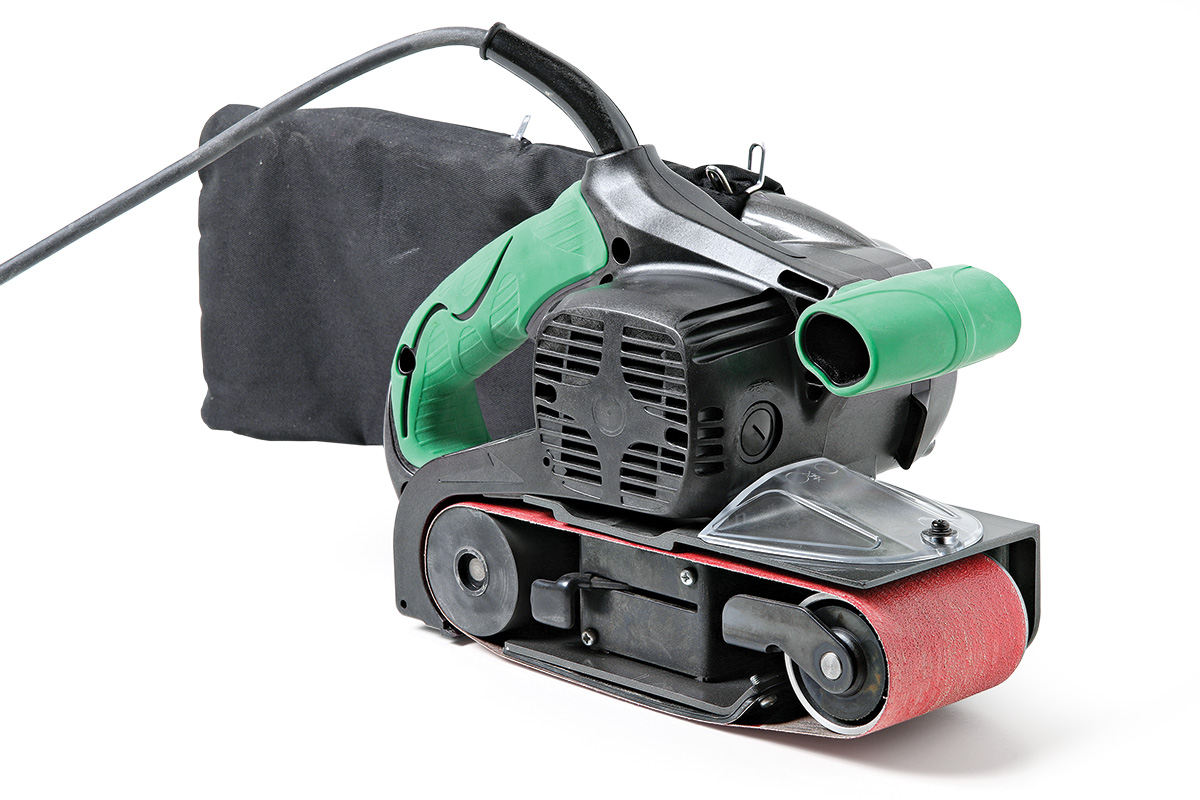
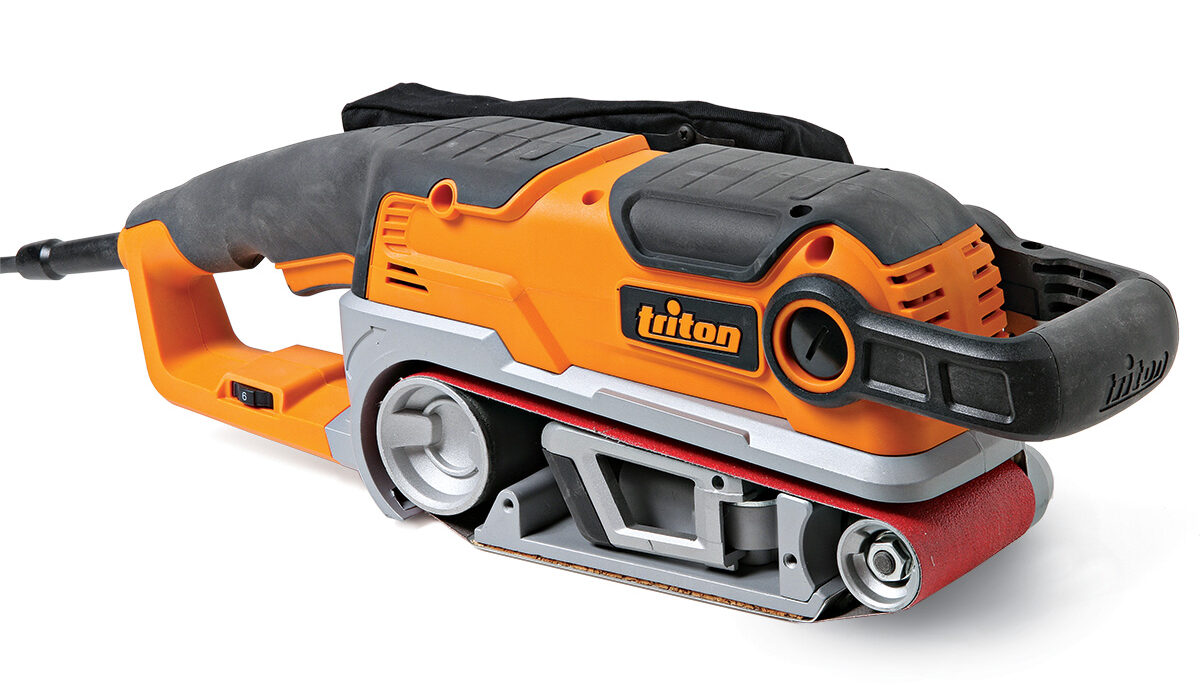
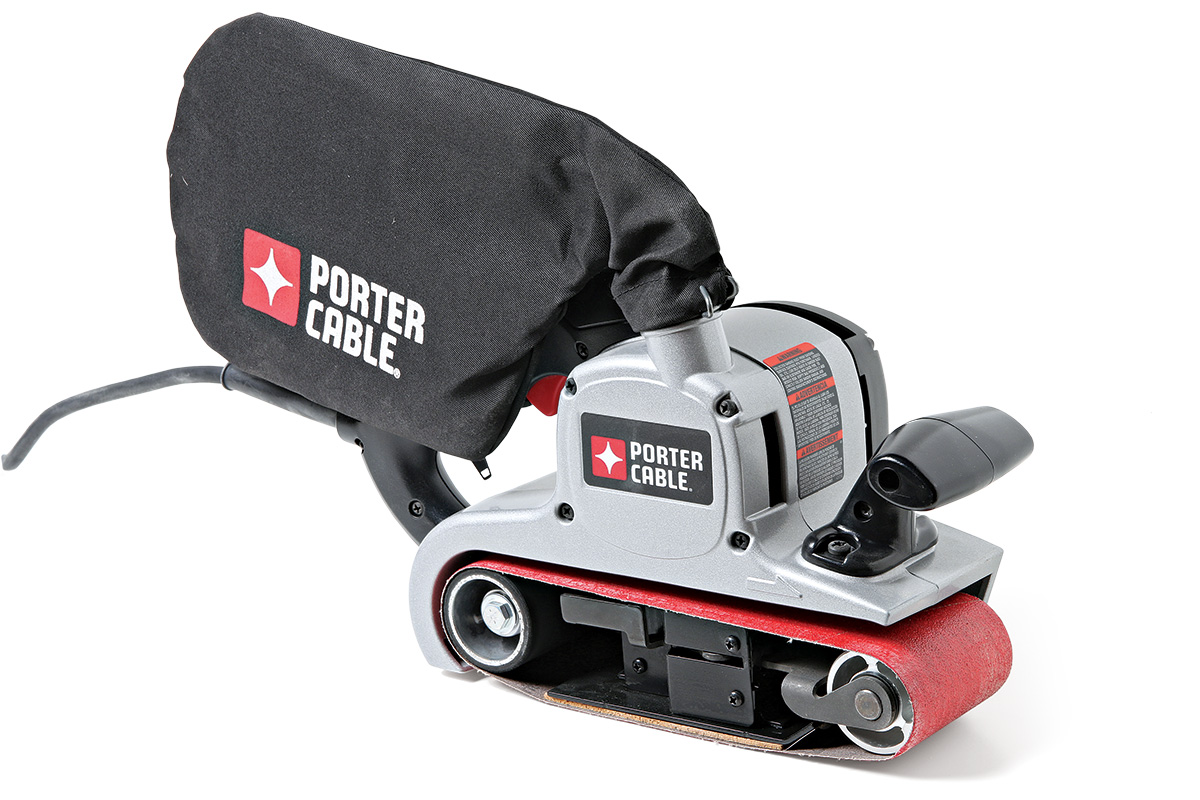

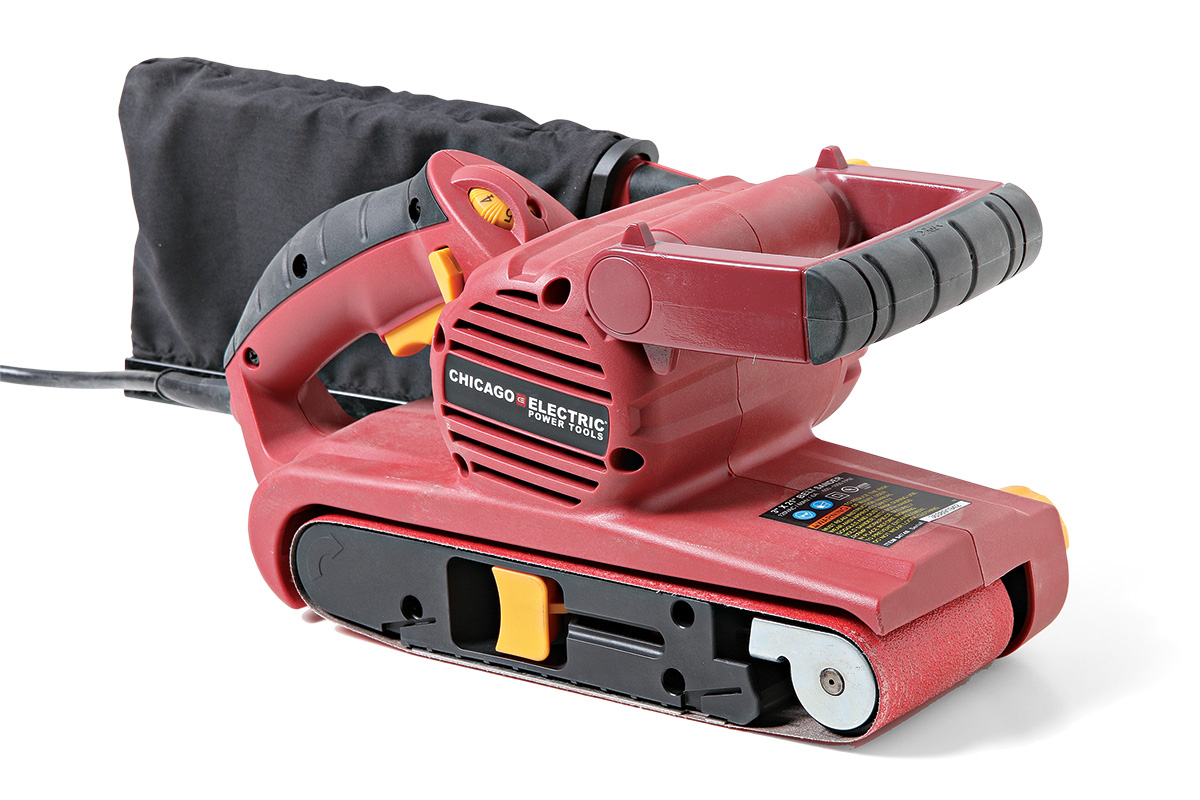
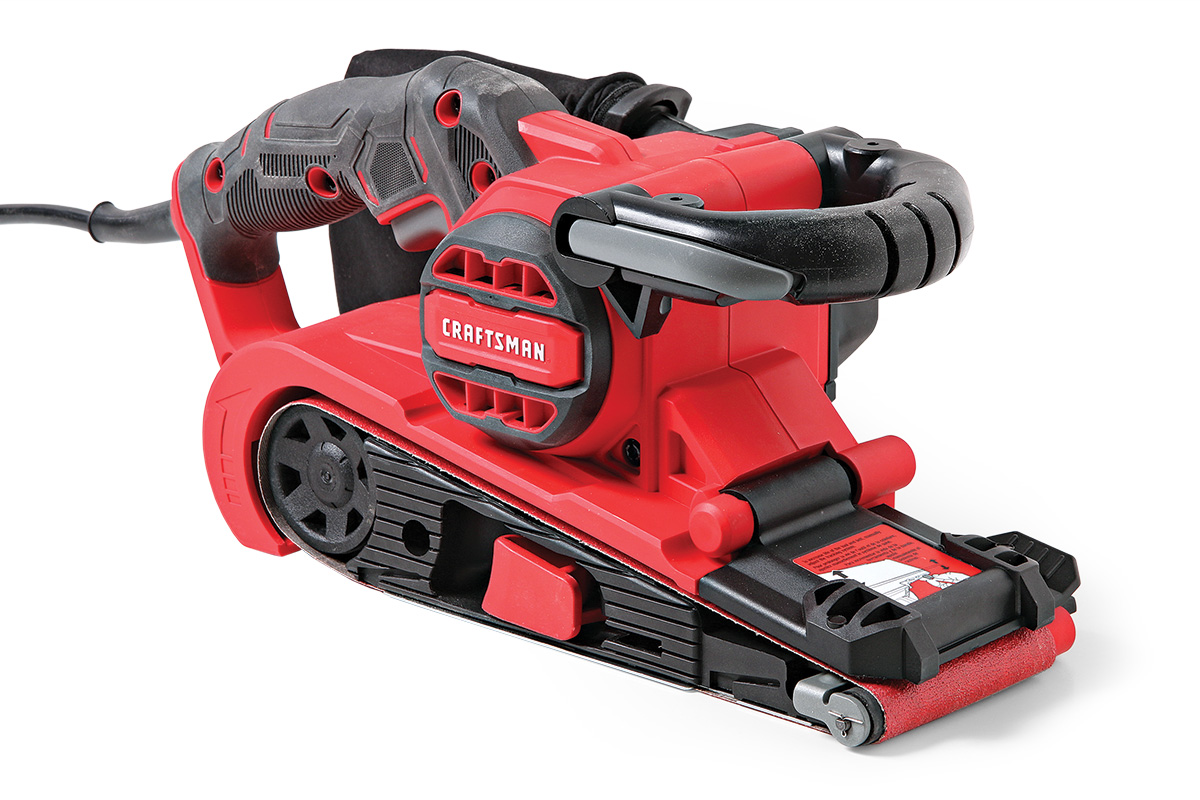

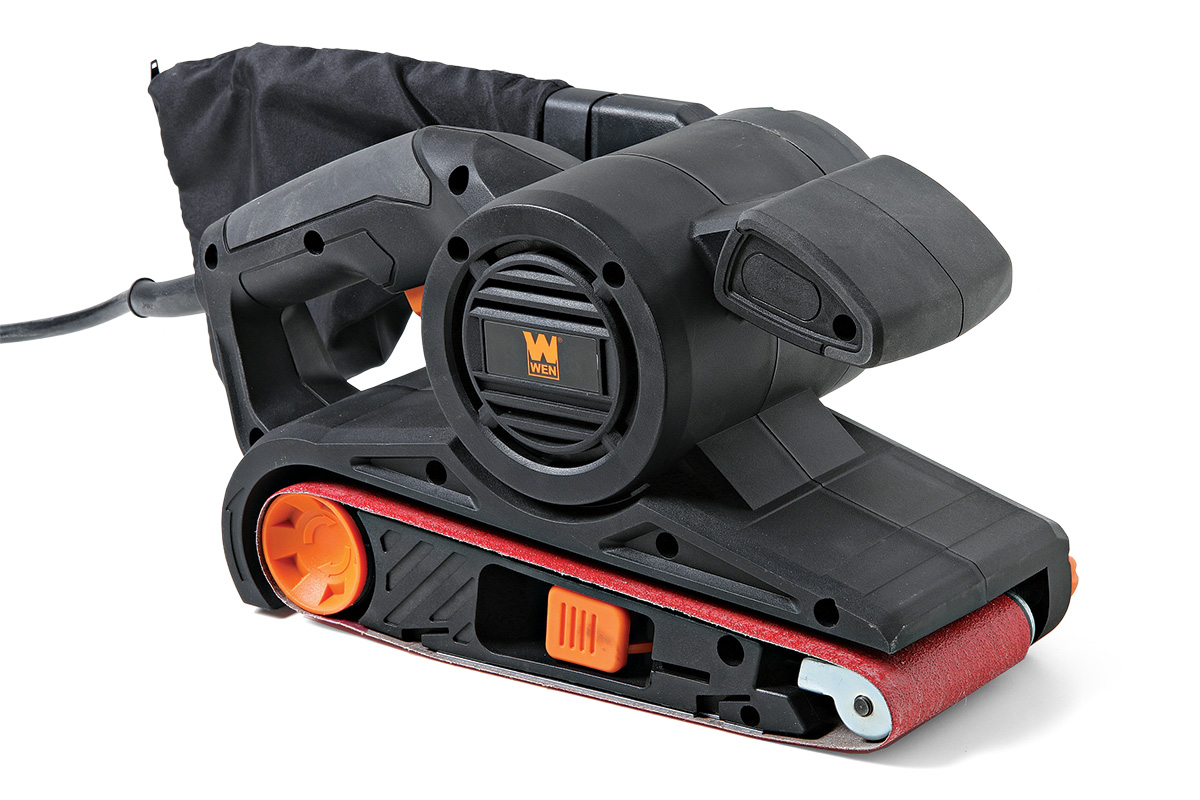
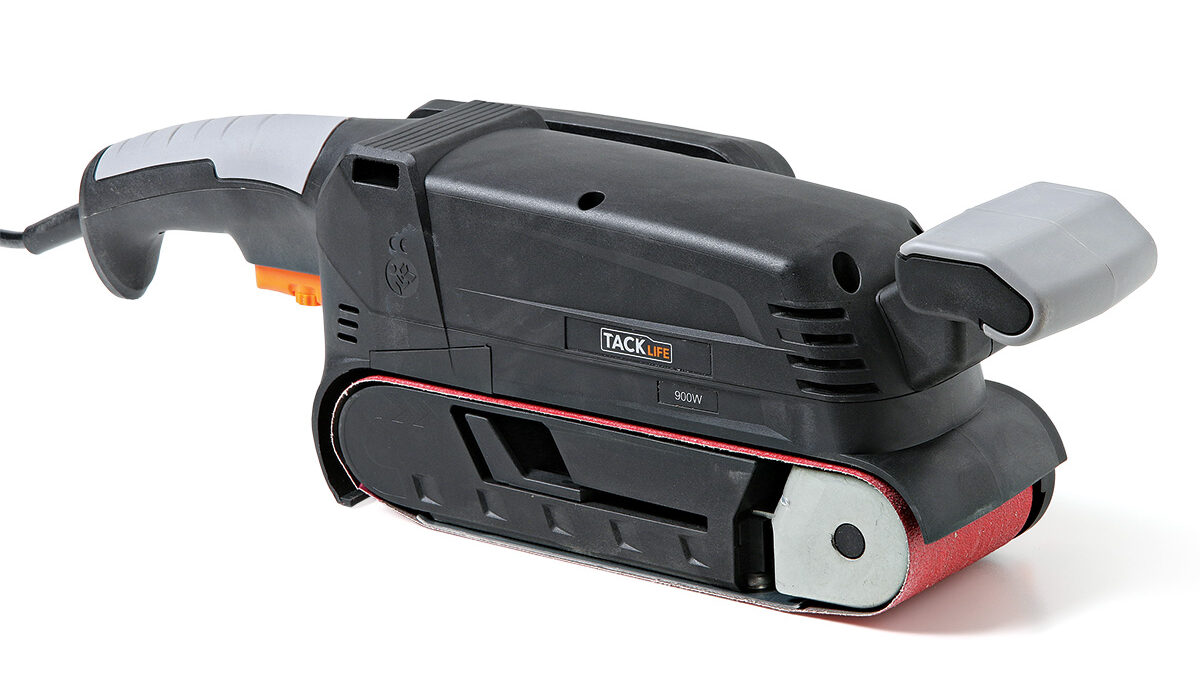




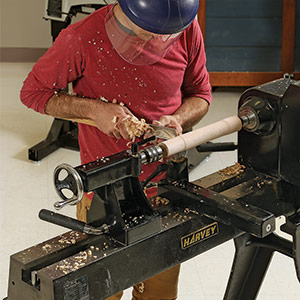
















Comments
So what do you think was the variable in removal rates? How significant was the range? Maybe the belt speeds/revolutions? I know machines are getting better and quality at the top is getting narrower so variance amongst the top 5(+/-) is small but a measurable criteria.
I thought everything was going cordless these days. Won't these be obsolete like, next week?
Log in or create an account to post a comment.
Sign up Log in